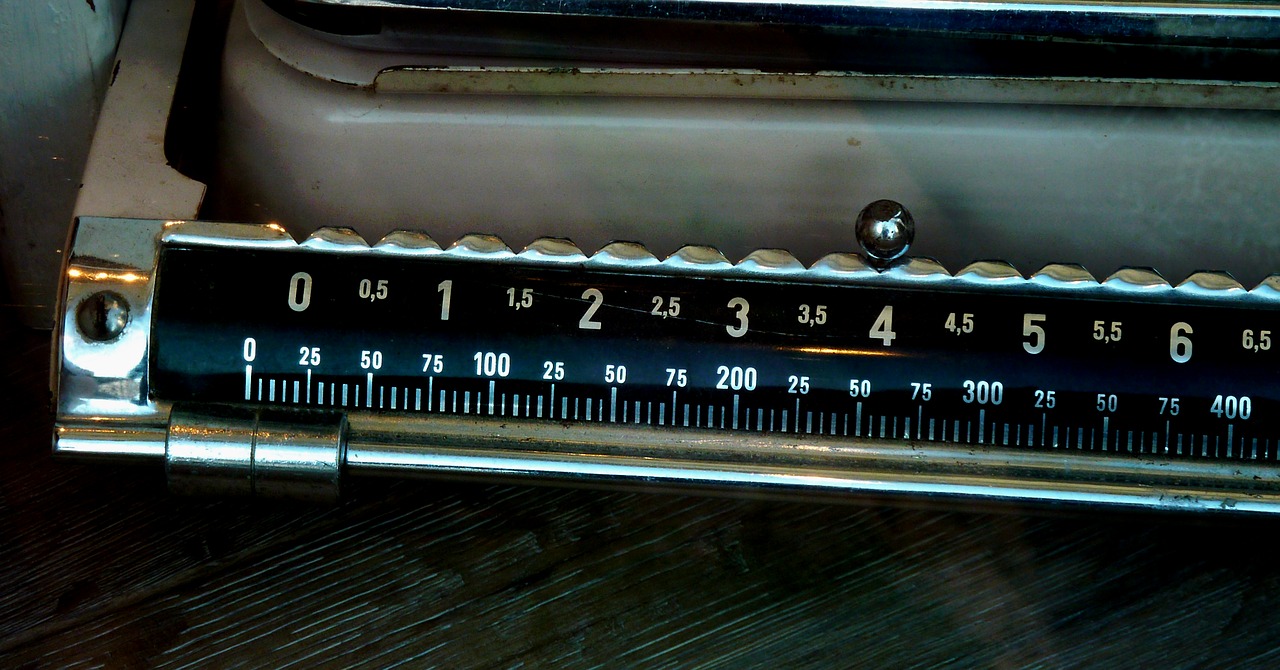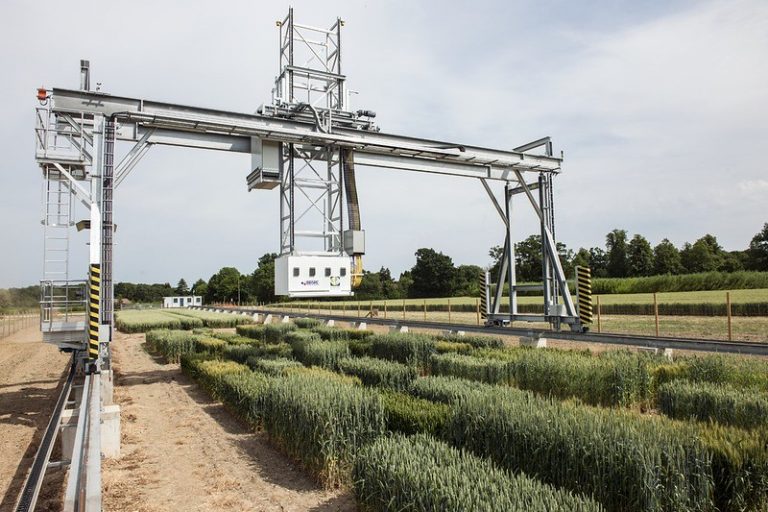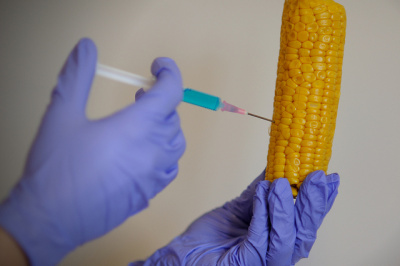Actualités
GMO: labelled or not, depending on the chosen unit

In April 2017, the European Commission’s Joint Research Center (JRC) published a report on the quantification of GMOs: it shows the Commission’s will to artificially reduce measured quantities of GMOs in food and feed products. Consequence? GMOs are present but not labelled. Short tutorial on measurement units…
The mandate given by the JRC in 2015 to a working group of the European Network of Laboratories on GMOs (ENGL [1]) is based on the observation that « a certain degree of confusion was generated and still remains on the unit of expression of the GM percentage” [2]. The origin of this confusion is not scientific but legislative (see table below)! The ENGL was therefore instructed “to prepare an overview of the state of discussion about the relationship between copy numbers and mass [the two existing units] for the main GM crop species”. The goal is to be able to justify, on scientific grounds, a political decision that wishes GM contents to be expressed in weight rather than in DNA copy numbers. These scientific grounds came in April 2017 with a report [3] signed not by the ENGL but by the JRC, the institute which hosts it, after being re-read by… the European Commission!
A labelling threshold of 0.9%: yes, but 0.9% of what?
Regulations 1829/2003 and 1830/2003, adopted in 2003, require that food and / or feed containing or produced from GMOs be labeled. There is an exemption in case of accidental or technically unavoidable presence when the GM content (authorized in the EU of course) is less than 0.9% [4] [5]. This percentage of GMO is calculated ingredient by ingredient: for example, 100g of food containing 10g of corn, composed of 0.5g GM corn, and 90g of tomato, will be labeled because the GM corn content will be calculated by reference to the 10g of corn (i.e 0.5g / 10g, in total 5%), and not by reference to the 100g of the food (0.5g / 100g, int total 0.5%). When the 0.9% threshold for an ingredient considered individually is exceeded, the presence of the GMO must be mentioned with the name of the GM species concerned. Conversely, a food consisting of rice composed of 0.3% GM rice, wheat composed of 0.6% GM wheat and rapeseed composed of 0.8% GM rapeseed will not be labelled, each ingredient considered individually having a GM content below the labelling threshold. This rule applies for any product except for certain feed (see below the box “botanical impurities”)…
0.9%, very well. But what unit does it refer to? What are we measuring? Regulations 1829/2003 and 1830/2003 remain silent on this subject. It is in 2004 that the European Commission recommended that the expression of the result of GM analysis be in “DNA unit” [6]. This recommendation is in line with the decisions of the ENGL network which had chosen the DNA unit, considering DNA is more stable throughout the processing chain and measurement techniques [7]. The European Commission recommendation is also consistent with Regulation 641/2004 adopted the same year. The Regulation requires companies marketing GM foodstuffs or GM feeds (excluding plants) to provide reference material (seeds, DNA, plasmids, GM and non-GM), as well as information on of the GMO detection, the use of the PCR technique to quantify the GMO being clearly preferred. This preference implies the result of the analysis- whether definitive or intermediate – is expressed in the “DNA unit”. In 2007 and again in 2008, the ENGL formalized its opinion and officially recommended the DNA unit [8].
With this DNA unit, things are clear: with the reference material supplied by the companies (crushed seeds or mixed leaves), the ENGL starts from a mass unit (being the only one known at this stage) and deduces the corresponding reference DNA unit. In order to calculate the GM content of commercial samples, the number of the detected copies of the GM DNA is linked to the number of copies of a gene specific to the plant species concerned [9].
A direct consequence: the contents of GMOs will decrease… mathematically!
Despite the scientific uncertainties that this would entail (see below), the JRC’s report published in April 2017 responds to the European Commission request by declaring it is possible to change the unit. One of the consequences is that converting a result expressed in DNA unit to a result expressed in mass unit will in many cases lead to a mathematical drop in the GMO content in a lot! Indeed, many lots containing more than 0.9% of GMO when expressed in DNA unit will not be labelled when the GM content is expressed in mass fraction because the threshold of f 0.9% will not be exceeded! But the “well-chosen” examples in the JRC report do not show that. Indeed, if a seed contains, for example, three GM transformation events, each event will participate to the amount of GM DNA (a corn containing one transgene will have a lower GM content than a corn containing six transgenes). But if the unit is seed or mass, regardless of the number of copies, the amount will not change (1g of maize containing six transgenes remains 1g of corn). The same happens when the GM plant is homozygous (the GM transformation events are present in two copies) or heterozygous (the GM transformation events are present in one copy).
However, the JRC report does not reflect this in the examples it gives. concerning GM maize soybean content expressed in DNA % and in mass fraction. The results expressed in mass for soy are always equal to those expressed in DNA unit. And in the case of corn, they are even superior! But…
It is necessary to read the explanation given by the JRC concerning the calculation s: “The values of the [conversion factor] used in this example are fictive”! In other words, the authors invented values and applied them to the results as a percentage of DNA to obtain the mass result …
Above all, the examples given are not innocent. Regarding soy, this plant is non only homozygous but above all, the two selected GM soybeans have only one GM transformation event. Corn is heterozygous in marketed hybrids and again, the three maize varieties have only one transgenic event. These are indeed the only cases where the content will not change or will even be higher when DNA unit is converted in mass unit. But the lack of examples of what will be most commonly encountered, namely GMOs with two, three… eight GM stacked events is striking. Because in these cases, even with fictitious values, the significant reductions in GM content that the change of unit would induce would be visible. In the end, the picture seems to have been drawn in order to give the impression that the new mass unit would not change anything, or would even increase the GMO content…
From 2011, things get vague
To make such a change of unit is not the result of a scientific need but of a legal unclarity. If until 2011, things are clear, everything changes from then on.
The case of unauthorised GMOs in the European territory creates an opportunity to install a legal uncertainty. Before 2011, there were no rules applicable to these GMOs and each Member State did more or less what it wanted. It is because of these different practices to manage these unauthorized GMOs that Regulation 619/2011 was adopted in 2011. This Regulation states that the contents of GMOs are to be expressed in “mass fraction”, not DNA. A choice that requires scientists to make a conversion, since they only know how to measure DNA throughout the different chains (10). The ENGL scientists did not fail to recall this in 2015, thus expressing their preference for the DNA unit (11).
But let’s go back to 2011. From then on, and despite the words of caution of the ENGL scientists, political decisions take the upper hand and the scientific recommendations of the scientific network are not followed even though this network was specially created by… political authority. In 2013, a new Regulation that lays down rules concerning the marketing GMPs intended for food or feed uses, in its turn, the mass fraction (Regulation N. 503/2013). As the 2004 Regulation, the 2003 Regulation provides that the company must provide reference material and a description of the method of detection of the GMO – the PCR technique being once again preferred, which implies the results of the analysis are to be expressed in a “DNA unit”. But this time, the Regulation specifies that, for reference materials, the certified value of the GMO content must be given in mass fraction, information expressed in DNA unit being required only “if this data is available”.
Y. Bertheau (Inra): lies and cover-ups
Inf’OGM – What do you think about the JRC report from a ENGL Working Group of which you are one of the four co-founders in 2004?
Yves Bertheau – Deliberate omission is always considered in our culture as a lie. As such, the lack of examples on the effect of stacking on the labelling of GM or derived products and the narrowing of the considerations of the Working Group and the JRC to the sole seeds, as opposed to a from fork to fork approach as described in the initial mandate, is clearly a way to hide the effect of the change of unity on the labels intended to inform consumers, and on the production and coexistence capacities of GMO and non-GMO crops.
Considering the composition of the Working Group, together with several European officials, and the intervention of the Health DG for a final “proofreading”, we must ask ourselves to what extent a very strong political pressure or advice lead to this text that contradicts scientific considerations.
As in the documents of the Bureau on the Coexistence of the Seville JCR or the opinion on the coexistence of HCB of 2012, we find here the pre-eminence of socio-economic and non-scientific considerations of experts with the aim to introduce those products at all costs..
In fact, contrary to what the Working Group’s mandate decides to postulate, the initial mass certification of crushed seeds of the reference materials does not in any way require abandoning the reliable and precise DNA unit used for more than a decade in international trade.
This mass unit worries scientists because they cannot work directly in mass fraction to measure the GM content. This means they must convert the measured DNA unit in mass fraction. However, the conversion factor that is used makes the results uncertain, as it depends on many biological factors and therefore on species, varieties, parental origins for hybrids… (12). But the ENGL must comply with political decisions. And in 2015, it updates its 2008 technical recommendation by adding a reference to “a specific unit, such as the number of targeted sequence copies [DNA unit] or the mass of GM material.”
The 2017 JCR report: scientific uncertainties, biases and gaps
The conversion requirement is confirmed by the JRC in its 2017 report: “GM results that are primarily expressed as GM-DNA copy numbers […] shall be translated into mass fraction”. The use of a conversion factor is thus inevitable. However, the JRC also confirms that the “uncertainty associated with this conversion factor” will be adding to the already existing “measurement uncertainty”. An accumulation of uncertainties that does not seem to disturb the JCR, the instance that hosts the ENGL: the JCR doesn’t seem to think it doesn’t hold water..
In addition to the artificial reduction of the GMO content already mentioned at the beginning of this article, there is another consequence. The mandate of the Working Group refers to a summary of the state of discussions on the subject. This implicitly requires to consider the food chain from the producer to the consumer. However, only the issue of seeds is raised, because it is the only material currently traceable when using the new mass unit. Nowhere in the report do the authors discuss processed products nor unknown GMOs. Unlike seeds, the basic material used is not known in these two cases (processed products and unknown GMOs). This means the reference material to be used to apply a conversion factor will remain unknown, since the analysts will not know to which biological properties they should link the analysed plant parts. The traceability link between reference material and the sample will be lost beyond the seed or crushed seed. This sounds like a technical impasse – unless it is a trick – for the labs that will have to do the checks using such a protocol.
An icing on the cake?
The report also recommends to initiate a comprehensive study on conversion factors. This would not be without advantage for the JRC as it allows it’s Institute for Reference Materials and Measurements (IRMM) to strengthen its near-monopoly and keep fundings and positions: in the current Community configuration, this study would indeed be the JRMM’s responsibility to conduct… Considering that the report praises the merits of a technology called digital PCR (which is nevertheless described as not yet “used routinely” in detections), there seems to be a very promising market.
Accumulating uncertainties does not seem to disturb the JRC. Indeed, in its conclusion, there is not one word of caution to the legislator that it would be scientifically correct to apply the DNA unit for all the legal texts. .On the contrary, it concludes by saying that a study on the calculation of the conversion factors based on new reference materials must now be engaged. It also says that, in a second step, such an approach will have promoted and adopted at ISO level! But to loosen the regulations will benefit some countries, like the American countries producing GMOs, and they are surely ready to accept it as it will ease their exports.
The conclusion of the JRC raises questions because of the uncertainty of the scope of the mandate given by the European Commission. A position of the latter is now awaited following the publication of this report of the JRC. in a dossier where “good science” has been claimed at every stage of the debate by the European legislator and by companies, the former persists in giving a bad example (13). This report highlights that the legislator did not follow the initial and consensual recommendations of its experts concerning the unit of measurement of the percentage of GMOs. It also highlights that, rather than recalling what is “good science” to the legislator, some of these experts are put up with an accumulation of uncertainties in the context of economic imperatives discreetly stated by the Commission…
| Year | Legal text | Subject | % | Unit |
| 2001 | Directive 2001/18 | Deliberate release of GMOs (cultivation, importation, unconfined research trials) | Not specified (14) | Not specified |
| 2003 | Regulation 1829/2003 | Placing on the market of GM food and feed | 0,9 | Not specified |
| 2003 | Regulation 1830/2003 | Labelling of GM food and feed products | 0,9 | Not specified |
| 2004 | Recommendation 2004/787 | Technical guidance for sampling and detection of GMOs | 0,9 | DNA |
| 2011 | Regulation 619/2011 | Analysis of feed as regards presence of GMOs for which an authorisation procedure is pending or the authorisation of which has expired | 0,1 | Mass fraction |
| 2004 | Regulation 641/2004 | Detailed rules concerning (among others) the reference material for the application for the authorisation of new GM food and feed (other than plants) | DNA | |
| 2013 | Regulation 503/2013 | Detailed rules concerning (among others) the reference material for the application for the autorisation of GM food and feed (plants) | Mass and DNA |
Botanical impurities or component of the feed: the same quantitity of GMO can lead to labelling or not
To “escape” the labelling of GMO products intended for feed, are there other “tricks” than changing the measurement unit possible? We are in 2004, May 26 and 27 precisely, and the legislation on GMO labelling has been adopted the previous year. During these two days, Member States are meeting with the European Commission within the Standing Committee on the Food Chain and Animal Health.
At the request of Belgium, Member States discuss the implementation of Regulation 1829/2003 which states that the labelling of feed containing GMOs is mandatory when the proportion of GMOs exceeds 0.9 % of the feed and each of its components.
But how does one apply this threshold when a genetically modified plant is present in a non-genetically modified animal feed? For example, if a feed lot consists-ing primarily of non-genetically modified corn is contaminated with genetically modified soybeans? Should the 0.9% threshold be calculated in relation to the amount of soy, considered as a component of the feed, or in relation to the amount of corn if the genetically modified soy is considered a botanical impurity?
The minutes of May 26-27 (15) are very informative. They indicate that in this case, GM soy is considered a botanical impurity because “soya could not be regarded as a feed in accordance with the definition of feed laid down in Regulation (EC) No 178/2002 because it was not intended to be used for oral feeding, it was present as an impurity”. Botanical impurities comprise impurities of plant materials which do not adverse effects on the animals, such as straw and seeds of other cultivated species or weeds (16).
A simple technical detail? The authors of the JRC report recall that the GM content of botanical impurities must be calculated in relation to the total mass of the animal feed rather than the mass of the species present as a botanical impurity. More specifically, for GMOs in a non-GM feed, this means that if a batch of 100 kg of non-GM maize for animal feed contains 0.5 kg of GM soy, the presence of GM soy will not have to be mentioned on the label as animal feed. In fact, in the case of botanical impurities, the threshold for these impurities to become components of the batch is set at 5% (17), and it is therefore only when this threshold is exceeded that the GM soy must appear on the label as animal feed. But above all, when one applies this rule, the GM soy content will be 0.5% (0.5 kg of GM soy compared to 100 kg of corn) and not 100% (0.5 kg of GM soy compared to 0.5 kg soy) and the presence of this GMO will not be mentioned on the label!
When asked to confirm this “botanical impurities” status applied to GMOs present in animal feed (with the legal documents establishing it), the European Commission replied that it is “currently analysing the issues [status and content] concerning the interplay between the labelling provisions of the GMO legislation and the feed legislation”. A discussion with the Member States is planned “by the end of 2017”.
[1] The ENGL’s purpose is to develop guidelines and methods for detection and quantification of Genetically Modified events. L’ENGL est en charge de l’élaboration des lignes directrices et des validations de méthodes concernant la détection et quantification des évènements génétiquement modifiés (GM).
[2] Mandate for an ENGL Working Group on Unit of Measurement (WG-UoM) Approved by the ENGL Steering Committee on 11th February 2015
[3] JRC Technical report, Recommendation for the unit of measurement and the measuring system to report traceable and comparable results expressing GM content in accordance with EU legislation
[5] The 0,9 % threshold applies where the presence of the GMO in the food or feed is is adventitious or technically unavoidable. If the presence of GMOs is intentional, labelling is compulsory whatever the threshold.
[6] European Commission, Recommendation of 4 October 2004 on technical guidance for sampling and detection of genetically modified organisms and material produced from genetically modified organisms as or in products in the context of Regulation (EC) No 1830/2003.
[8] ENGL Explanatory Document on the use of “percentage of GM-DNA copy numbers in relation to target taxon specific DNA copy numbers calculated in terms of haploid genomes” as a general unit to express the percentage of GMOs puis Definition of Minimum Performance Requirements for Analytical Methods of GMO Testing, ENGL 13 October 2008
[9] A sequence specific to a plant species is a sequence allowing to identify the specie and being stably present in a low number of copies, allowing to count the number of haploid genome (examples : maize = 2 haploid genomes, sweet wheat = 6 haploid genomes)











